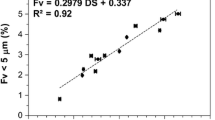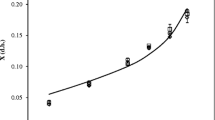Abstract
Pearled amaranth grains obtained by abrasive milling were processed by planetary ball milling to produce amaranth flours. The influence of milling energy on rheological and thermal behavior of amaranth flour dispersions and stability during 24 h storage at 4 °C were investigated based on a factorial design. The rheological behavior of flour dispersions (4 % and 8 % w/v) was determined using a rotational viscometer, while gelatinization degree was determined by differential scanning calorimetry as a measure of structural changes.The power law model was found to be suitable in expressing the relationship between shear stress and shear rate. Flour dispersions showed a pseudoplastic behavior. However this character decreased with the storage being dependent on flour concentration and milling energy. A decrease of the consistency index and an increase of the flow behavior index were observed as a result of the increasing milling energy. Gelatinization enthalpy decrease showed the loss of crystalline structure due to ball milling. Amaranth flour dispersions presented increasing stability during storage. It was observed, that the stability changed with the concentration of amaranth flours.Thus, more stable dispersions were obtained as the flour concentration increased. The highly milled sample was the most stable sample during the storage.



Similar content being viewed by others
References
AOAC (2000) Official methods of analysis, 17th edn. Gaithersburg, M.D, Association of Official Analytical Chemists
Autio K, Eliasson A-C (2009) Starch chemistry and technology. Food Sci Technol 579–587
Bhattacharya S, Bhattacharya S (1994) Flow behavior of cooked maize flour suspensions and applicability of mathematical models. J Food Process Eng 17:263–278
Bhattacharya S, Bhattacharya S (1996) Rheology of cooked debranned maize flour suspensions. J Food Eng 27:97–105
Bodroza-Solarov M, Filiocev B, Kevresan Z, Mandic A, Simurina O (2008) Quality of bread supplemented with popped amaranthus cruentus grain. J Food Process Eng 31:602–618
Campanella OH, Mix NC, Hamaker BR (2002) Consequence of starch damage on rheological properties of maize starch pastes. Cereal Chem 79:897–901
Chen J, Lii C, Lu S (2003) Physicochemical and morphological analyses on damaged starches. J Food Drug Anal 11:283–289
Dhital S, Shrestha AK, Flanagan BM, Hasjim J, Gidley MJ (2011) Cryo-milling of starch granules leads to differential effects on molecular size and conformation. Carbohydr Polym 84:1133–1140
Dhital S, Shrestha AK, Gidley MJ (2010) Effect of cryo-milling on starches: functionality and digestibility. Food Hydrocoll 24:152–163
Fiorda F, Manoel S, Jr S, Da-Silva F, Grosmann M, Souto L (2013) Microestructure, texture and colour of gluten-free pasta made with amaranth flour, cassava starch and cassava bagasse. Food Sci Technol 54:132–138
Han M, Chang M, Kim M (2007) Changes in physicochemical properties of amaranth starch processed by ultra-fine pulverization. J Appl Biol Chem 50:234–238
Hasjim J, Li E, Dhital S (2012) Milling of rice grains: the roles of starch structures in the solubility and swelling properties of rice flour. Starch-Stärke 64:631–645
Huang Z, Lu J, Li X, Tong Z (2007) Effect of mechanical activation on physico-chemical properties and structure of cassava starch. Carbohydr Polym 68:128–135
Ibanoglu S, Ibanoglu E (1999) Rheological properties of cooked tarhana, a cereal-based soup. Food Res Int 32:29–33
Kaur L, Singh N, Singh Sodhi N (2002) Some properties of potatoes and their starches II. Morphological, thermal and rheological properties of starches. Food Chem 79:183–192
Loubes M.A, Calzetta A.N, Tolaba M.P, Suarez (2012) Mechanical and thermal characteristics of amaranth starch isolated by acid wet-milling procedure. Food Sci Technol 46:519–524
Manohar RS, Manohar BN, Rao PH (1998) Rheological characterization of wheat porridge (cooked dalia), a semi-liquid breakfast food. Cereal Chem 27:103–108
Martinez-Bustos F, Lopez-Soto M, San Martin-Martinez E, Zazueta-Morales J, Velez-Medina J (2007) Effects of high energy milling on some functional properties of jicama starch (Pachyrrhizus ersus L. Urban) and cassava starch (Manihot esculenta Crantz). J Food Eng 78:1212–1220
Morrison W, Tester R (1994) Properties of damaged starch granules. IV Composition of ball milled wheat starches and of fractions obtained on hydration. J Cereal Sci 20:69–77
Rao MA (1999a) Flow and functional models for rheological properties of fluid foods. Rheol Fluid Semisolid Foods:25–58
Roa DF, Santagapita PR, Buera MP, Tolaba MP (2013) Amaranth milling strategies and fraction characterization by FT-IR. Food Bioproc Technol. doi:10.1007/s11947-013-1050-7
Roa D-F, Santagapita P-R, Buera M-P & Tolaba M-P (2014) Ball milling of Amaranth starch-enriched fraction. changes on particle Size, starch crystallinity, and functionality as a function of milling energy. Food Bioproc Technol, doi 10.1007/s11947-014-1283-0
Sanz-Penella JM, Wronkowska M, Soral-Smietana M, Haros M (2013) Effect of whole amaranth flour on bread properties and nutritive value. LWT-Food Sci Technol 50:679–685
Sanguanpong V, Chotineeranat S, Piyachomkwan K, Oates C, Chinachoti P, Sriroth K (2003) Preparation and structural properties of small-particle cassava starch. J Sci Food Agric 83:760–768
Singh J, Singh N (2003) Studies on the morphological and rheological properties of granular cold water soluble corn and potato starches. Food Hydrocoll 17:63–72
Tester RF (1997) Properties of damaged starch granules: composition and swelling properties of maize, rice, pea and potato starch fractions in water at various temperatures. Food Hydrocoll 11:293–301
Wang H, Sun DW, Zeng Q, Lu Y (1999) Flow behavior and rheological models of rice flour pastes. J Food Process Eng 22:191–200
Acknowledgments
The authors acknowledge the financial support from PME-2006-01685, UBACYT (Project UBACyT 20020130100442BA).
Author information
Authors and Affiliations
Corresponding author
Rights and permissions
About this article
Cite this article
Roa, D.F., Baeza, R.I. & Tolaba, M.P. Effect of ball milling energy on rheological and thermal properties of amaranth flour. J Food Sci Technol 52, 8389–8394 (2015). https://doi.org/10.1007/s13197-015-1976-z
Revised:
Accepted:
Published:
Issue Date:
DOI: https://doi.org/10.1007/s13197-015-1976-z




